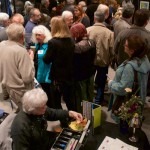A grove of giant sequoias in the San Jacinto Mountains? Yes indeed!
One sultry day this summer, I was hiking with friends up one of my least favorite routes, the Black Mountain Trail. The day’s weather only made it worse, but as we passed 7,000 feet and approached the saddle at the head of Hall Canyon, high above Lake Fulmor, I noticed something odd in the corner of my eye.
The scattered incense cedars here seemed slightly off-color and uncharacteristically lush. It hit me that I was seeing not cedars, but a cluster of nearly 40-year-old Sequoiadendron giganteum trees.
I’d recently learned about them while consulting on the history of Lake Fulmor with botanist Rudolf Schmid of the University of California, Berkeley. Last year Dr. Schmid published evidence that this population of trees has been proliferating naturally and now ranges over 17 acres.
On a recent trek through the grove he plotted at least 158 thriving specimens. So sequoias should now be considered not merely curiosities cordoned off in a distant national park, but naturalized residents here in Southern California.
How did they get here? Old-timers on the Hill will remember the huge Soboba Fire of 1974, which started on the Indian reservation near Valle Vista and spread across some 18,000 acres, denuding the northwest slopes of Black Mountain and Fuller Ridge. In its aftermath, the Forest Service undertook a massive reforestation program to restore the burnt area. Along with a variety of pine and oak species, sequoia seedlings were planted on about five acres of mountainside high on the northwestern flank of Black Mountain.
This was hardly the first instance of sequoia planting in these parts. Hill residents are familiar with the line of sequoias in front of the Idyllwild School and in the yard of Jo’An’s Restaurant, the most prominent being the village Christmas tree. Once you know what to look for, you’ll notice ornamental sequoias scattered throughout our area, from the flats below Idyllwild Arts to the upper reaches of Fern Valley.
This all started in the 1940s. In 1941 Marion Michael Null, a physician and human perpetual-motion machine, retired with his wife to Idyllwild to pursue his love of horticulture. They settled in a trailer and set about planting their 1.5 acres. But as a former medical missionary to Asia and natural leader, Null couldn’t resist community involvement.
Starting with First Aid instruction for the locals during World War II, Null soon was repeatedly elected president of the Chamber of Commerce. In that role he collaborated with Town Crier publisher Ernie Maxwell in 1948 to create the Izaak Walton League chapter that would shape Idyllwild’s long-lasting conservation ethic.
By then Null’s wife had passed away, and his horticultural hobby had become focused on growing sequoia trees from seed. He mounted a single-minded campaign to popularize them as ornamental additions to the village. But he also led the chamber and the league to urge the Forest Service to include sequoias in its continual reforestation efforts.
If your curiosity is piqued, the easiest approach to see the Black Mountain sequoias is from the Boulder Basin campground just below the peak. Black Mountain Road from Highway 243 takes you there, though it’s a good idea to check at the ranger station regarding its condition, as the upper reaches of this road were badly damaged by recent thunderstorms.
The Black Mountain Trail descends from Boulder Basin in a series of switchbacks that quickly bring you to the saddle, where you’ll find sequoias ranging from seedlings to young trees as tall as 20 feet.











Cool article! Who wrote this?